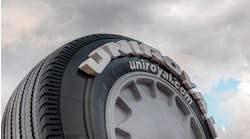Tire Rack Inc. kicked off its 20th year of tire tests by comparing four ultra high performance, all-season tire brands: Continental’s new ExtremeContact DWS 06, Goodyear’s Eagle F1 Asymmetric All-Season, Michelin’s Pilot Sport A/S 3 and Pirelli’s P Zero All Season Plus.
A summary of Tire Rack’s findings follows:
Continental ExtremeContact DWS 06 (Ultra High Performance All-Season, 245/40R18 97Y)
Liked: Good road manners and wet traction.
Improve: Bump up dry traction a bit to match the best in class.
Conclusion: Another solid performer from Continental.
Goodyear Eagle F1 Asymmetric All-Season (Ultra High Performance All-Season, 245/40R18 93Y)
Liked: Quick steering response.
Improve: Increase wet traction to keep pace with category leaders.
Conclusion: A tire that delivers crisp handling.
Michelin Pilot Sport A/S 3 (W- or Y-Speed Rated) (Ultra High Performance All-Season, 245/40R18 97Y)
Liked: Nimble handling and impressive ultimate grip, especially in the wet.
Improve: Soften the ride a little.
Conclusion: Dry and wet handling leader in the category.
Pirelli P Zero All Season Plus (Ultra High Performance All-Season, 245/40R18 97W)
Liked: Civilized on the road along with nimble handling on the track.
Improve: Bump up ultimate dry and wet traction a bit if it wouldn't upset this tire's fine balance.
Conclusion: A very refined ultra high performance all-season tire.
Tire Rack says that the majority of older ultra high performance all-season tires supplied strong dry and wet traction and handling, while providing minimal wintertime traction. However, with the advent of the game-changing Continental ExtremeContact DWS some six years ago, the driving landscape was changed. Suddenly, owners of high-performance cars looking for better winter mobility could get it with one tire designed to also perform well during warmer months, according to the company.
Although ultimate cornering capability may play well at a track day, most owners subject their high-performance cars to a far wider range of road surfaces, temperatures and conditions. For that reason Tire Rack testers head for public roads to evaluate noise comfort, ride quality and everyday handling. At the track, the one-third-mile course includes 90-degree street corners, a five-cone slalom and simulated expressway ramps. Tests are conducted in both wet and dry conditions, and allow the team to experience the traction, responsiveness, handling and drivability typically encountered only during emergency maneuvers or in competition.
On the road the Michelin’s responsiveness and tight, direct steering feel provided a slight edge over Continental, with Pirelli finishing a close third and Goodyear in fourth.
On less than perfect pavement the Pirelli held the advantage, doing what the testers called “a good job muting the sharpness of expansion joints and crudely patched potholes,” according to Tire Rack. Over the rough stuff the Conti again placed second, followed by Michelin and Goodyear. When combined, tread and impact noise levels for all four were tolerable, with Pirelli, Continental and Michelin tightly grouped in the team ratings. The noise score for the Goodyear tire was lower, due to its combination of tread noise and “booming” when encountering larger impacts.
Fuel economy was also measured, with worst-to-best within eight-tenths of a mile per gallon. None of these four models was designed to optimize fuel efficiency, but Goodyear scored highest in the category.
The tests were conducted at the company’s test track and on roads in and around South Bend, Ind. Test drivers used identically prepared 2014 BMW 328i sedans for the warm weather evaluation. (Winter condition testing by Tire Rack takes place in northern Sweden.)
For complete test results, visit the Tire Rack website.

